Bankfull Hydraulic Geometry Relationships for the Inner and Outer Bluegrass Regions of Kentucky
Abstract
:1. Introduction
2. Materials and Methods
2.1. Study Area
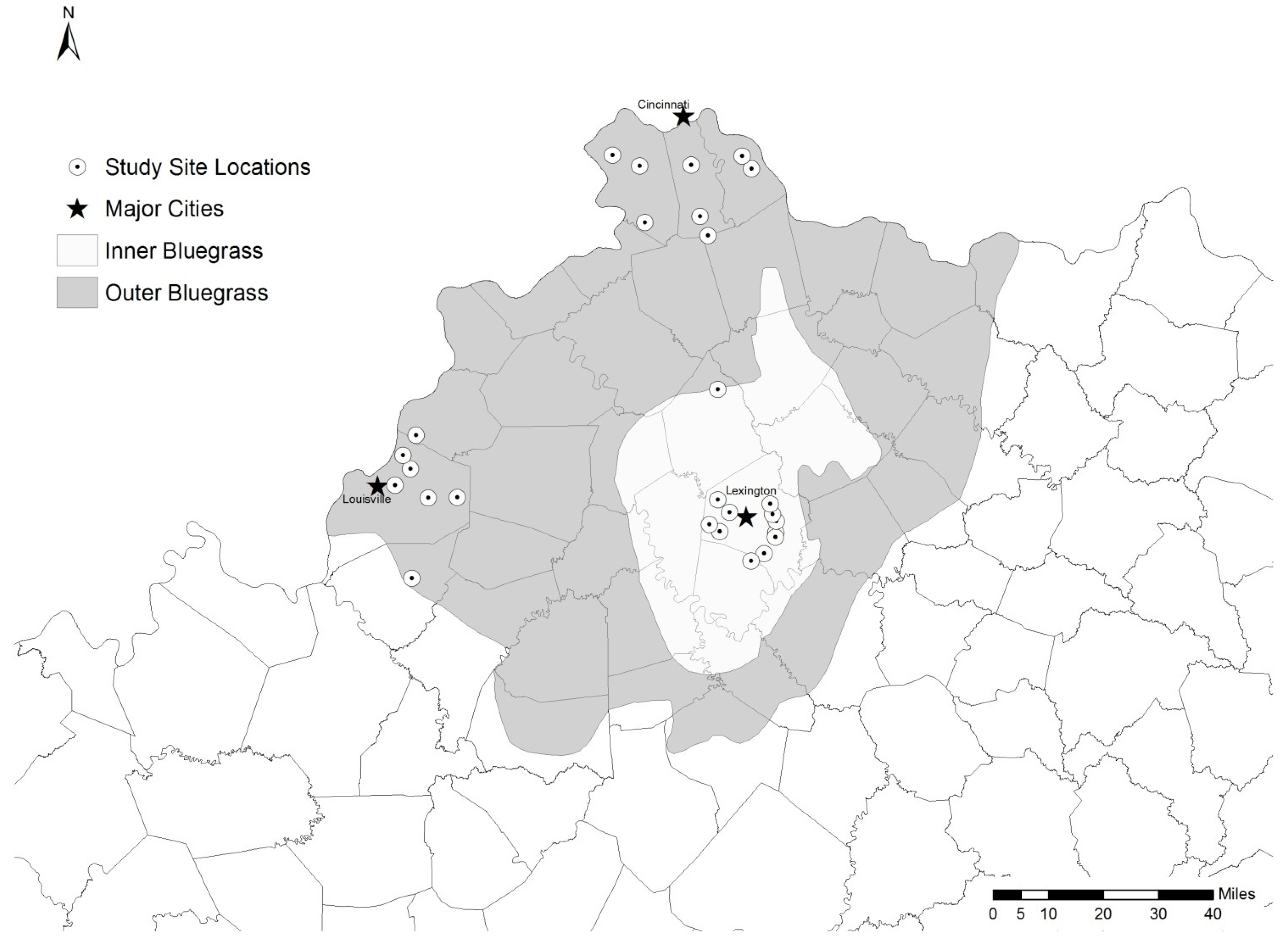
2.2. Stream Selection Criteria
- Drainage areas less than 390 km2 to allow for primarily wadable data collection.
- Single-threaded channels.
- Presence of readily identifiable bankfull indicators (listed in order of importance) such as (1) flat depositional surfaces, at a consistent elevation, immediately adjacent to the stream; (2) tops of point bars (if present); (3) prominent breaks in slope; and/or (4) erosion or scour features [43].
- Absence of severe bank erosion, bank armoring such as riprap, and streambank modifications.
- Bank height ratios (BHR) of 1.5 or less [44].
- Presence of verifiable reference marks at discontinued gage sites.
- Site accessibility meaning the stream reach was located on public property or landowner permission was granted.
2.3. Data Collection and Analysis
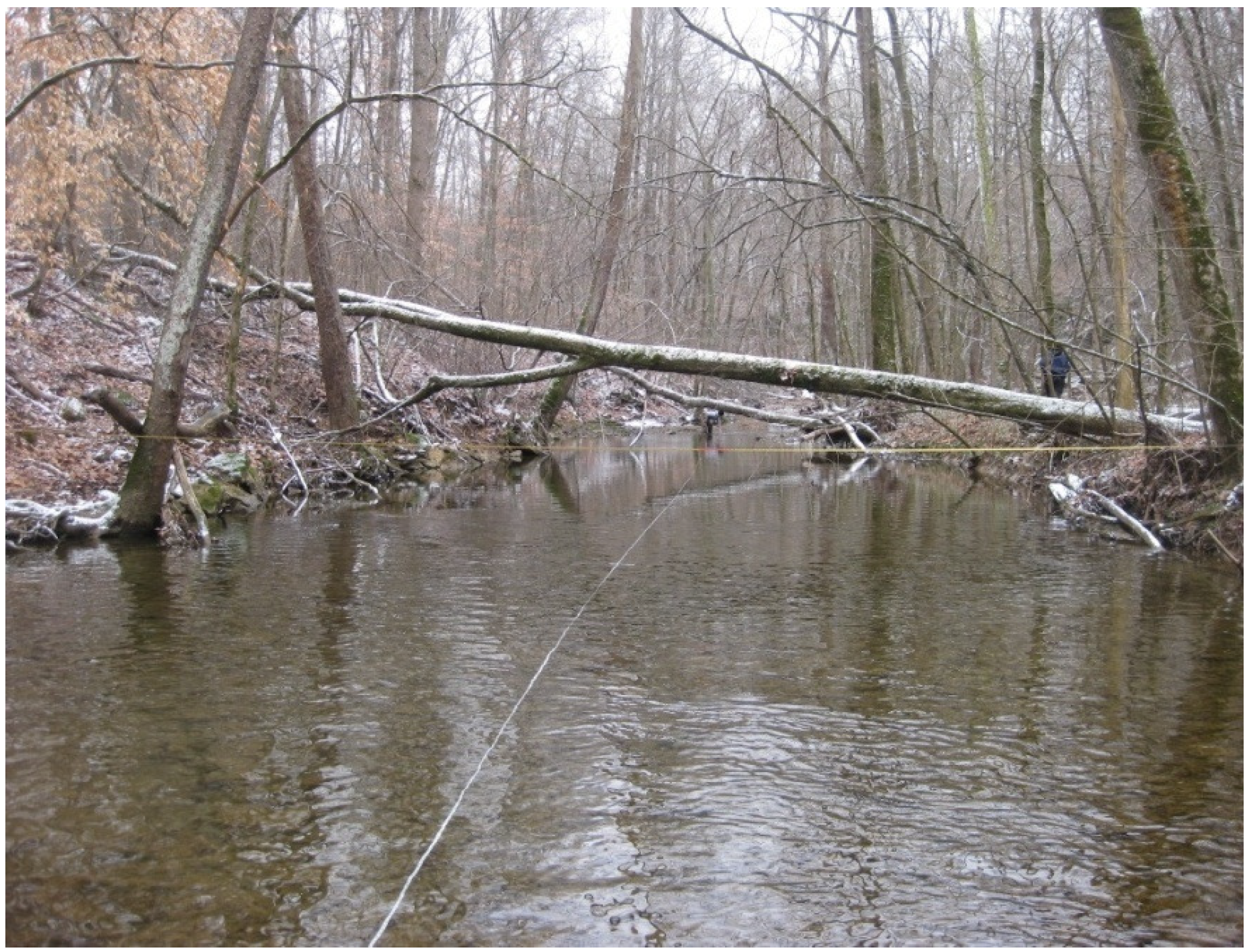
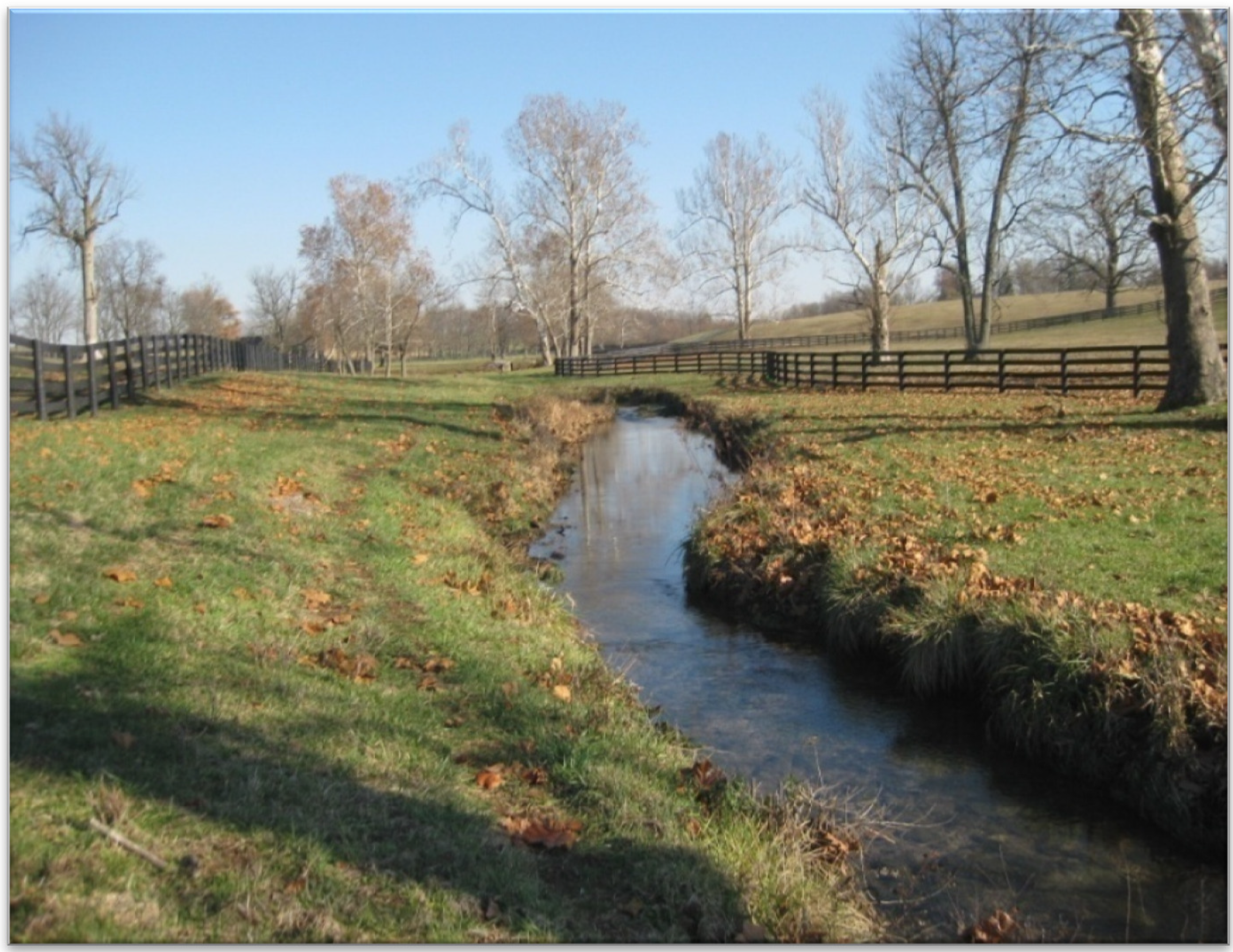
3. Results and Discussion
3.1. Bankfull Hydraulic Geometry Curves
| Site Location | USGS Gage Number | Bankfull Discharge (m3 s-1) | Bankfull Cross-Sectional Area (m2) | Bankfull Width (m) | Bankfull Mean Depth (m) | Bankfull Slope (m/m) | Bankfull Mean Velocity (m/s) | Return Interval (years) | Bankfull Indicator1 |
|---|---|---|---|---|---|---|---|---|---|
| Inner Bluegrass Region | |||||||||
| UT to East Hickman Creek at Chilesburg | 03284525 | 1.3 | 1.6 | 4.2 | 0.4 | 0.0063 | 0.8 | 1.03 | FDS, ESF |
| East Hickman Creek at Andover | 03284520 | 1.1 | 1.5 | 4.1 | 0.4 | 0.0058 | 0.7 | < 1.01 | FDS, PBS |
| Cave Creek near Fort Springs | 03288500 | 1.8 | 2.1 | 5.3 | 0.4 | 0.0074 | 0.9 | 1.27 | FDS |
| North Elkhorn Creek at Man O War Rd. | 03287580 | 1.7 | 3.1 | 5.9 | 0.5 | 0.0073 | 0.5 | 1.06 | FDS, TPB, PBS |
| North Elkhorn Creek at Winchester Rd. | 03287590 | 2.1 | 4.7 | 8.4 | 0.6 | 0.0046 | 0.4 | < 1.01 | FDS, PBS |
| Wolf Run at Old Frankfort Pk. | 03289193 | 11.9 | 9.2 | 11.6 | 0.8 | 0.0050 | 1.3 | < 1.01 | FDS, PBS |
| East Hickman Creek at Delong Rd. | 03284530 | 7.5 | 9.9 | 11.5 | 0.9 | 0.0025 | 0.8 | 1.01 | FDS, ESF |
| West Hickman Creek at Ash Grove Pk. | 03284555 | 12.9 | 13.8 | 17.8 | 0.8 | 0.0034 | 0.9 | < 1.01 | FDS, ESF |
| South Elkhorn Creek at Fort Springs | 03289000 | 15.4 | 11.8 | 16.5 | 0.7 | 0.0028 | 1.3 | 1.17 | FDS, TPB, PBS |
| North Elkhorn Creek at Bryan Station Rd. | 03287600 | 7.6 | 14.6 | 17.3 | 0.9 | 0.0032 | 0.5 | < 1.01 | FDS, PBS, ESF |
| Town Branch at Yarnallton Rd. | 03289200 | 30.6 | 21.9 | 21.9 | 1.0 | 0.0029 | 1.4 | 1.15 | FDS, PBS |
| Eagle Creek at Sadieville | 03291000 | 33.4 | 32.1 | 26.2 | 1.2 | 0.0016 | 1.0 | 1.24 | FDS, PBS |
| Outer Bluegrass Region | |||||||||
| Fourmile Creek at Polar Bridge2 | 03238772 | 4.4 | 4.1 | 8.0 | 0.5 | 0.0184 | 1.1 | < 1.01 | FDS, PBS, ESF |
| Chenoweth Run at Ruckriegel Pky.3 | 03298135 | 4.7 | 6.3 | 13.6 | 0.5 | 0.0053 | 0.7 | < 1.01 | FDS |
| Little Goose Creek near Harrods Creek3 | 03292480 | 7.7 | 10.9 | 13.7 | 0.8 | 0.0061 | 0.7 | 1.15 | FDS, ESF |
| Goose Creek at Old Westport Rd. 3 | 03292474 | 4.7 | 6.8 | 9.5 | 0.7 | 0.0053 | 0.7 | 1.09 | FDS, ESF |
| Cedar Creek at Hwy 14423 | 03297800 | 9.7 | 8.9 | 12.6 | 0.7 | 0.0050 | 1.1 | 1.02 | FDS, PBS, ESF |
| North Fork Grassy Creek near Piner2 | 03254400 | 10.3 | 8.6 | 13.0 | 0.7 | 0.0056 | 1.2 | < 1.01 | FDS, ESF |
| Cruises Creek at Hwy 172 | 03254480 | 10.6 | 14.8 | 15.8 | 0.9 | 0.0056 | 0.7 | < 1.01 | FDS, ESF |
| Middle Fork Beargrass Creek at Old Cannons Ln. 3 | 03293000 | 15.0 | 16.0 | 16.5 | 1.0 | 0.0037 | 0.9 | 1.23 | FDS |
| Woolper Creek at Woolper Rd. 2 | 03262001 | 15.3 | 15.8 | 18.4 | 0.9 | 0.0071 | 1.0 | < 1.01 | FDS, PBS |
| Banklick Creek at Hwy 18292 | 03254550 | 21.2 | 21.4 | 22.0 | 1.0 | 0.0051 | 1.0 | < 1.01 | FDS, ESF |
| Mud Lick Creek at Hwy 423 | 03277130 | 57.8 | 48.7 | 32.0 | 1.5 | 0.0053 | 1.2 | < 1.01 | FDS, PBS |
| Gunpowder Creek at Camp Ernst Rd. 2 | 03277075 | 46.4 | 26.1 | 26.9 | 1.0 | 0.0035 | 1.8 | < 1.01 | FDS, PBS |
| Twelvemile Creek at Hwy 19972 | 03238745 | 38.2 | 29.7 | 25.6 | 1.2 | 0.0025 | 1.3 | < 1.01 | FDS |
| Harrods Creek at Hwy 3293 | 03292470 | 54.1 | 47.9 | 28.1 | 1.7 | 0.0023 | 1.1 | 1.01 | FDS, ESF |
| Floyd’s Fork at Fisherville3 | 03298000 | 92.6 | 82.1 | 38.0 | 2.2 | 0.0010 | 1.1 | < 1.01 | FDS, PBS |
| Site Location | USGS Gage Number | Drainage Area (km2) | Percentage Impervious Area | Streamside Vegetation1 | Land Use (%) | ||
|---|---|---|---|---|---|---|---|
| Developed | Forest | Agriculture | |||||
| Inner Bluegrass Region | |||||||
| UT to East Hickman Creek at Chilesburg | 03284525 | 2.5 | 3.5 | Forest | 42.1 | 3.6 | 44.2 |
| East Hickman Creek at Andover | 03284520 | 4.1 | 12.0 | Grass/Forest | 41.1 | 11.3 | 46.7 |
| Cave Creek near Fort Springs | 03288500 | 5.0 | 21.6 | Grass | 64.4 | 5.6 | 29.7 |
| North Elkhorn Creek at Man O War Rd. | 03287580 | 5.7 | 3.2 | Forest | 23.7 | 17.6 | 54.5 |
| North Elkhorn Creek at Winchester Rd. | 03287590 | 10.5 | 9.8 | Forest | 31.9 | 12.5 | 53.2 |
| Wolf Run at Old Frankfort Pk. | 03289193 | 24.8 | 29.6 | Forest | 80.6 | 14.5 | 4.2 |
| East Hickman Creek at Delong Rd. | 03284530 | 39.1 | 13.7 | Grass | 44.1 | 7.6 | 44.1 |
| West Hickman Creek at Ash Grove Pk. | 03284555 | 53.1 | 24.2 | Forest | 73.1 | 15.1 | 9.9 |
| South Elkhorn Creek at Fort Springs | 03289000 | 54.9 | 13.1 | Forest | 43.7 | 15.5 | 39.5 |
| North Elkhorn Creek at Bryan Station Rd. | 03287600 | 55.7 | 12.0 | Forest | 33.7 | 8.3 | 56.6 |
| Town Branch at Yarnallton Rd. | 03289200 | 77.7 | 25.7 | Grass/Forest | 62.8 | 7.6 | 28.5 |
| Eagle Creek at Sadieville | 03291000 | 111.1 | 0.5 | Forest | 5.6 | 54.5 | 29.7 |
| Outer Bluegrass Region | |||||||
| Fourmile Creek at Polar Bridge2 | 03238772 | 8.0 | 6.5 | Forest | 27.9 | 39.9 | 26.6 |
| Chenoweth Run at Ruckriegel Pky.3 | 03298135 | 14.2 | 33.9 | Forest | 75.7 | 15.2 | 7.8 |
| Little Goose Creek near Harrods Creek3 | 03292480 | 15.0 | 18.7 | Forest | 64.0 | 27.9 | 7.1 |
| Goose Creek at Old Westport Rd. 3 | 03292474 | 15.5 | 11.1 | Forest | 51.6 | 36.5 | 10.3 |
| Cedar Creek at Hwy 14423 | 03297800 | 31.3 | 0.4 | Forest | 5.3 | 57.5 | 29.2 |
| North Fork Grassy Creek near Piner2 | 03254400 | 35.2 | 1.0 | Forest | 7.7 | 40.5 | 46.0 |
| Cruises Creek at Hwy 172 | 03254480 | 46.6 | 1.2 | Forest | 7.2 | 39.7 | 48.7 |
| Middle Fork Beargrass Creek at Old Cannons Ln. 3 | 03293000 | 49.0 | 24.4 | Forest | 73.7 | 20.1 | 3.8 |
| Woolper Creek at Woolper Rd. 2 | 03262001 | 62.7 | 4.1 | Forest | 20.9 | 38.4 | 35.1 |
| Banklick Creek at Hwy 18292 | 03254550 | 77.7 | 4.5 | Forest | 26.6 | 33.8 | 38.3 |
| Mud Lick Creek at Hwy 423 | 03277130 | 94.3 | 3.4 | Forest | 15.5 | 33.9 | 44.6 |
| Gunpowder Creek at Camp Ernst Rd. 2 | 03277075 | 94.8 | 16.7 | Forest | 52.9 | 20.7 | 21.9 |
| Twelvemile Creek at Hwy 19972 | 03238745 | 101.0 | 1.7 | Forest | 11.3 | 43.0 | 38.5 |
| Harrods Creek at Hwy 3293 | 03292470 | 182.1 | 1.4 | Forest | 8.7 | 39.9 | 48.3 |
| Floyd’s Fork at Fisherville3 | 03298000 | 357.4 | 2.4 | Forest | 13.2 | 39.9 | 41.9 |
| Source | Abkf | Wbkf | Dbkf | Vbkf | Sbkf | Wbkf/Dbkf | ||||||||||||
|---|---|---|---|---|---|---|---|---|---|---|---|---|---|---|---|---|---|---|
| g | h | R2 | a | b | R2 | c | f | R2 | k | m | R2 | t | z | R2 | x | y | R2 | |
| Inner Bluegrass | 1.69 | 0.80 | 0.93 | 4.39 | 0.50 | 0.93 | 0.39 | 0.30 | 0.87 | 0.59 | 0.20 | 0.42 | 0.01 | −0.32 | 0.72 | 11.39 | 0.20 | 0.73 |
| Outer Bluegrass | 1.59 | 0.83 | 0.95 | 5.16 | 0.44 | 0.94 | 0.31 | 0.39 | 0.85 | 0.63 | 0.17 | 0.43 | 0.02 | −0.51 | 0.65 | 16.72 | 0.05 | 0.06 |
| Sherwood and Huitger [54] | 0.61 | 0.87 | 0.93 | 1.97 | 0.50 | 0.90 | 0.31 | 0.37 | 0.85 | 1.65 | 0.13 | 0.22 | 0.06 | −0.48 | 0.30 | 6.40 | 0.14 | 0.30 |
| Wohl and David [30] | - | 0.803 | - | 1.12 | 0.50 | 0.59 | 0.58 | 0.30 | 0.48 | - | - | - | 0.08 | −0.33 | 0.28 | 1.96 | 0.19 | 0.09 |
| Leopold et al. [5]1 | - | 0.90 | - | - | 0.53 | - | - | 0.37 | - | - | 0.10 | - | - | −0.7 | - | - | - | - |
| Leopold et al. [5]2 | - | 0.903 | - | - | 0.50 | - | - | 0.40 | - | - | 0.10 | - | - | - | - | - | - | - |
| Knighton [23] | - | 0.863 | - | 2.61 | 0.50 | - | 0.31 | 0.36 | - | - | 0.14 | - | - | −0.2 | - | - | - | - |
| Hey and Thorne [48] | - | 0.803 | - | 3.67 | 0.45 | 0.79 | 0.33 | 0.35 | 0.80 | - | 0.20 | - | - | - | - | - | - | - |
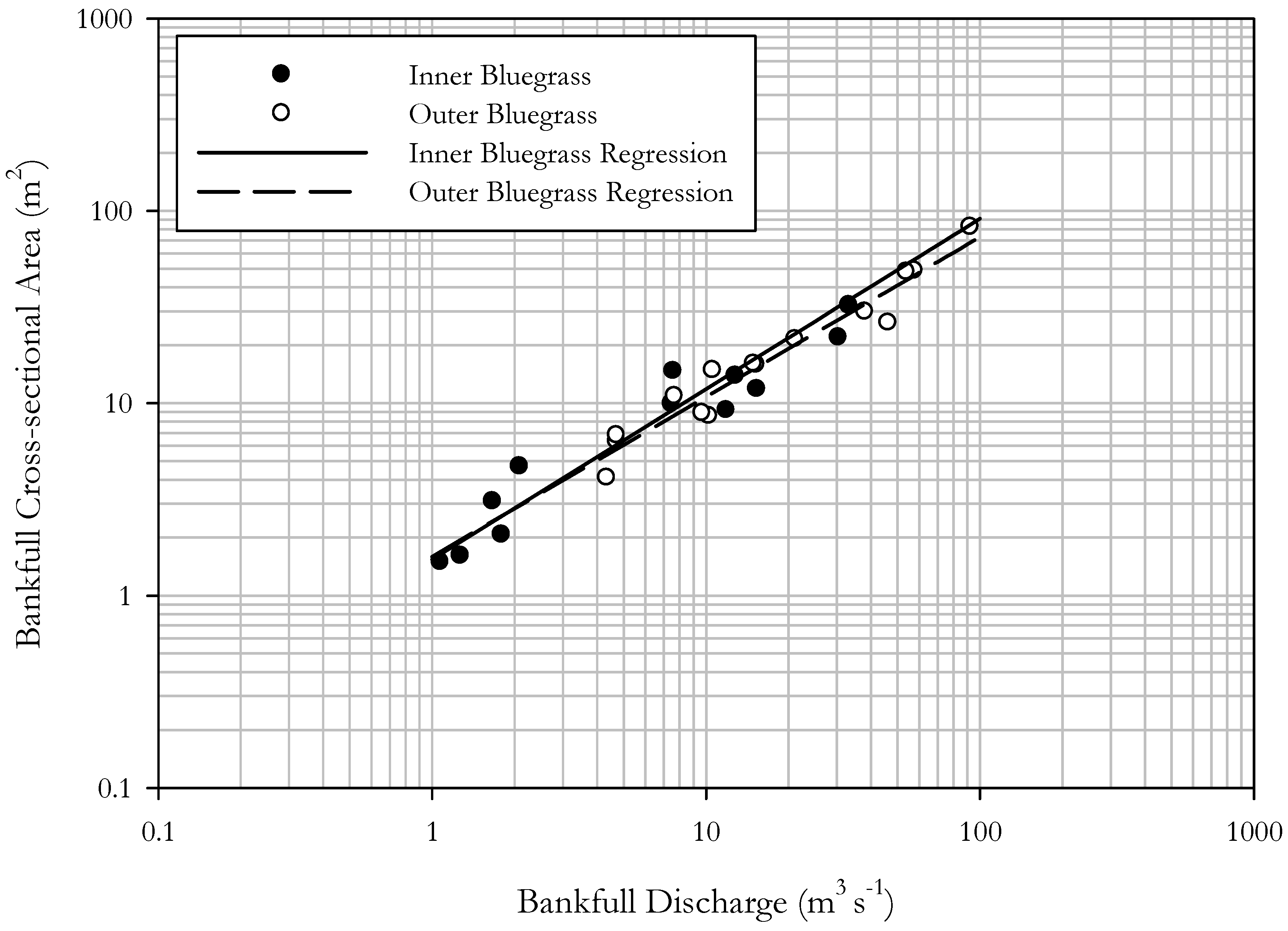
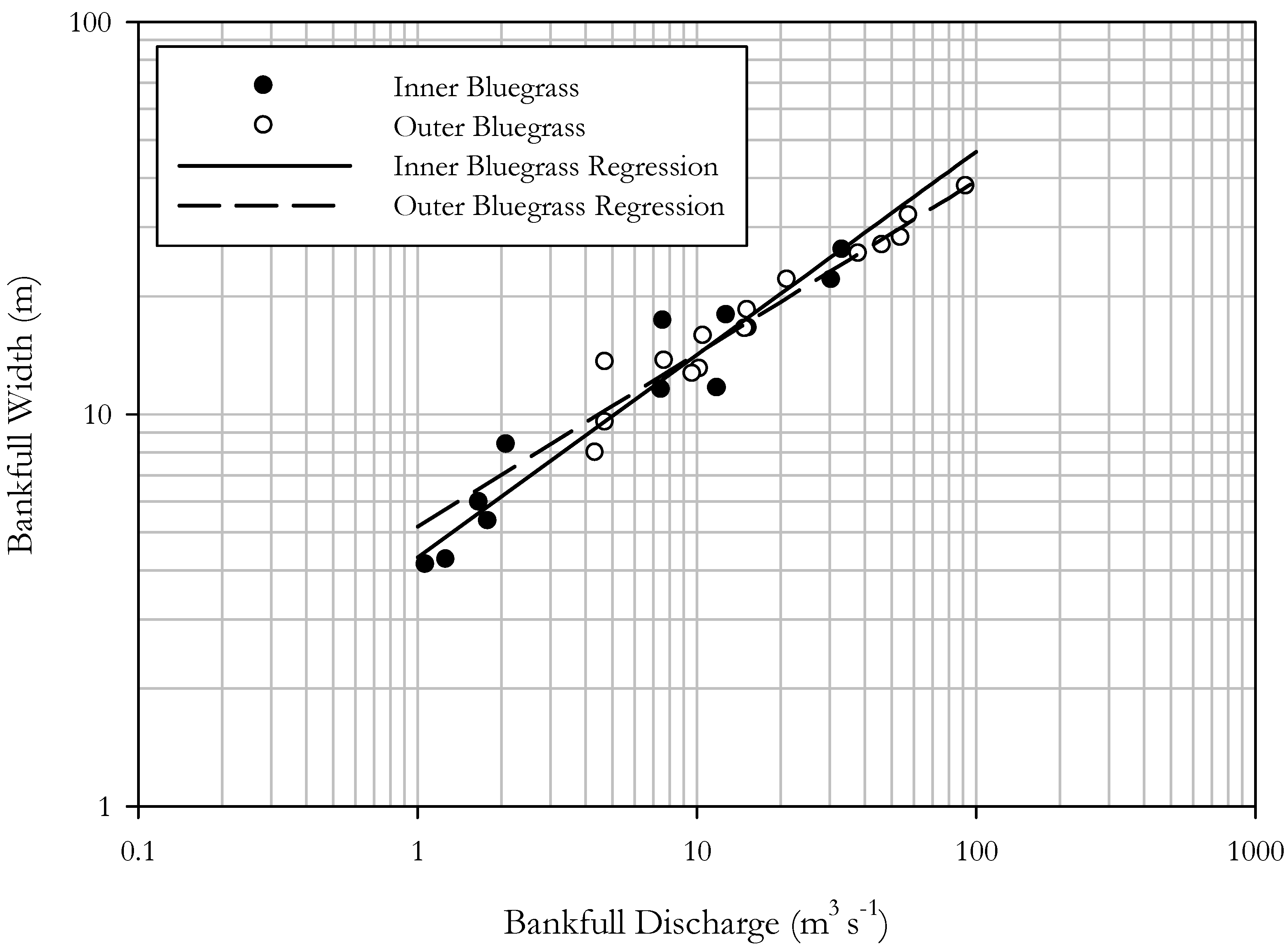
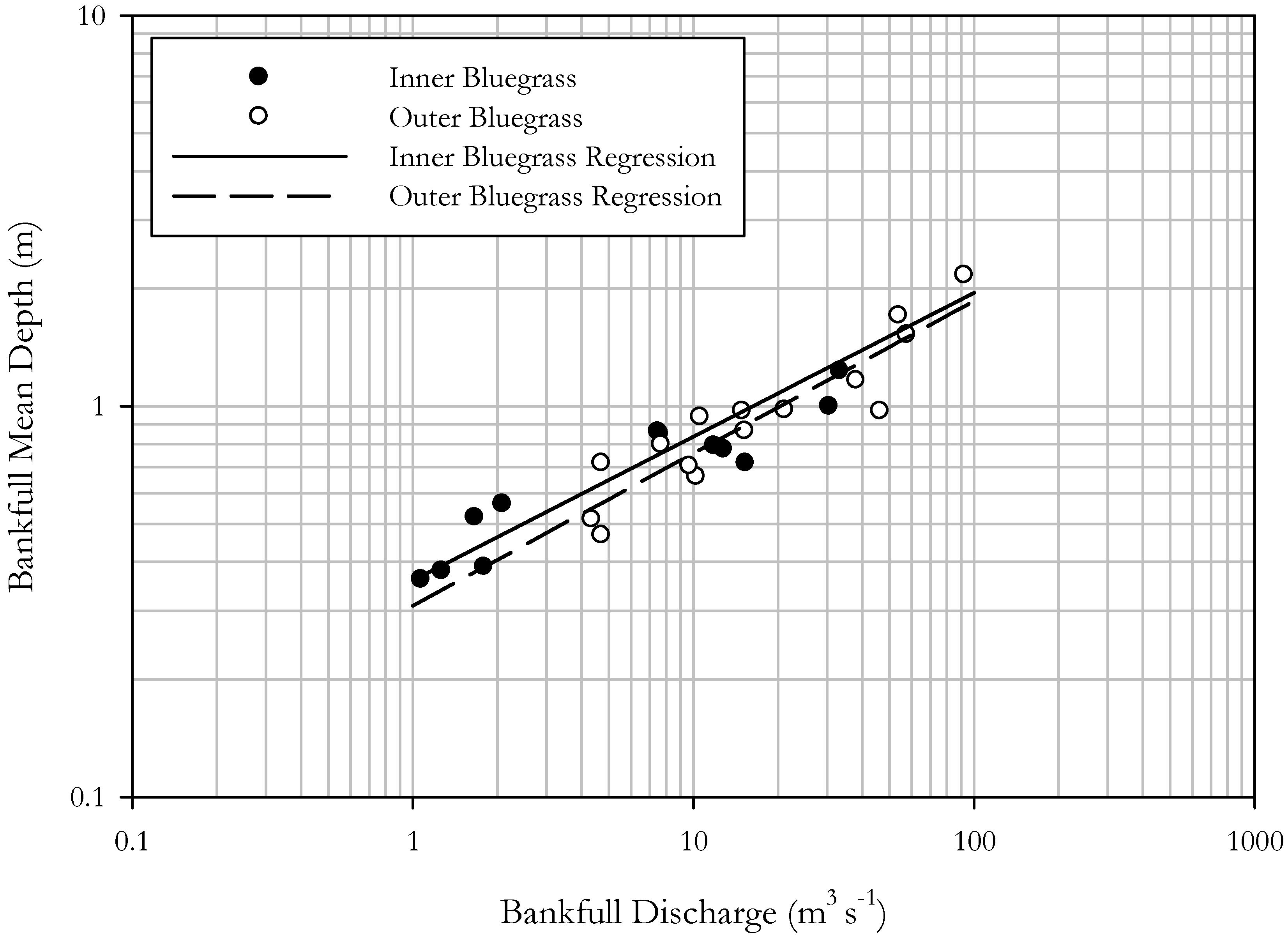

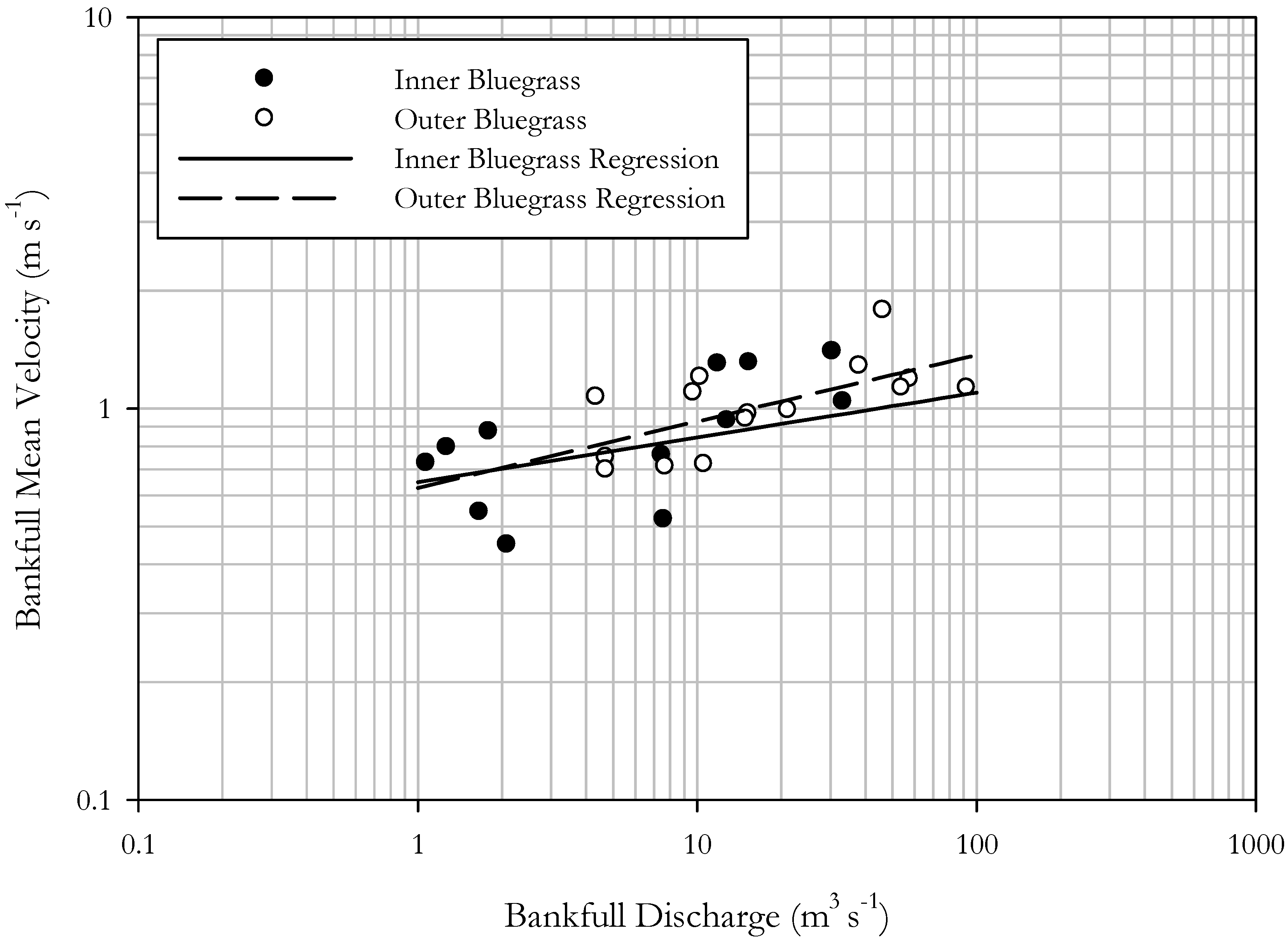
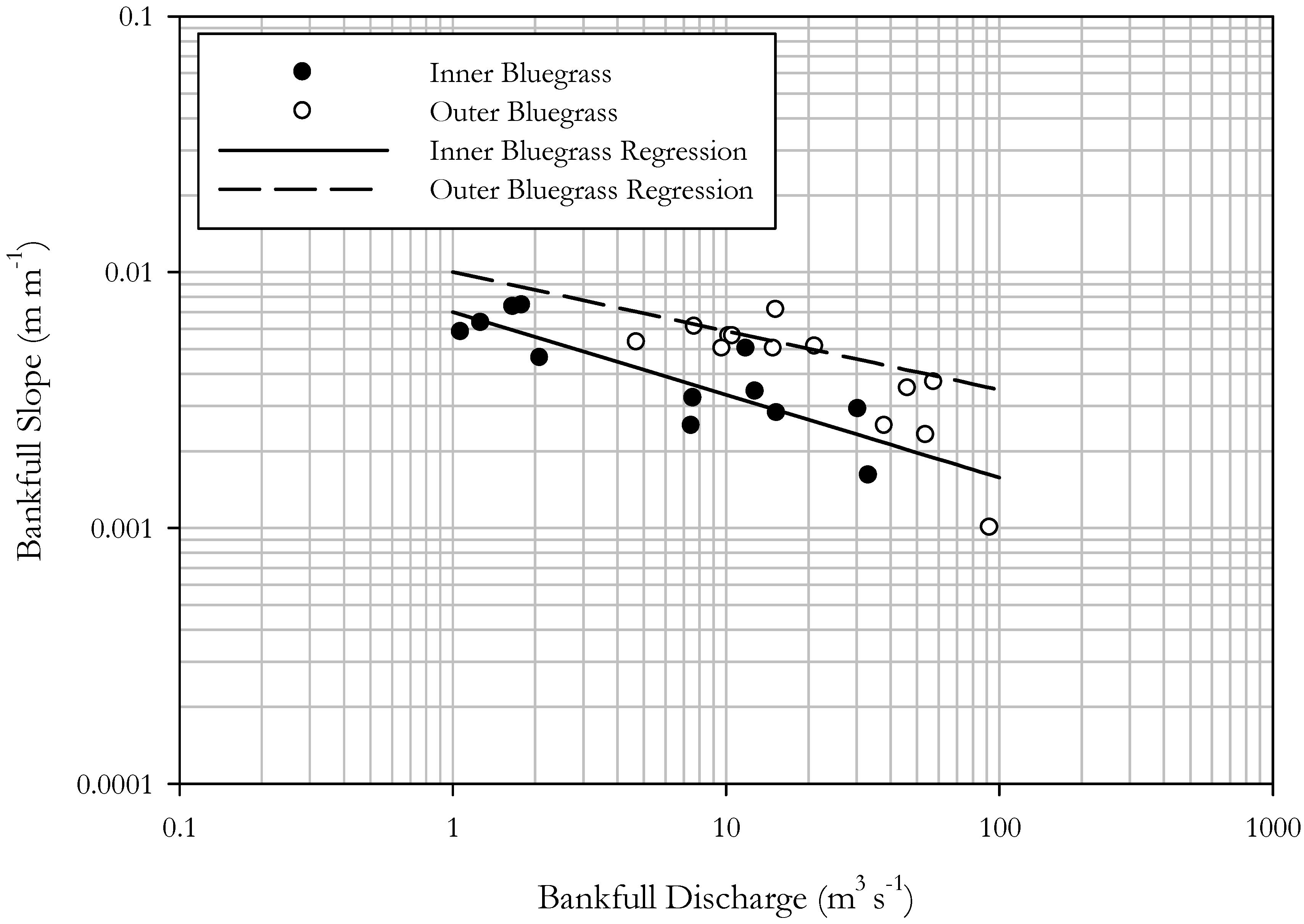

3.2. Bankfull Return Intervals
4. Conclusions
Acknowledgements
References and Notes
- Dunne, T.; Leopold, L.B. Water in Environmental Planning; W.H. Freeman: New York, NY, USA, 1978. [Google Scholar]
- Shields, F.D.; Copeland, R.R.; Klingeman, P.C.; Doyle, M. W.; Simon, A. Design for stream restoration. J. Hydraul. Eng. 2003, 129, 575–584. [Google Scholar] [CrossRef]
- Singh, V.P. On the theories of hydraulic geometry. Int. J. Sediment Transport 2003, 18, 196–218. [Google Scholar]
- Leopold, L.B.; Maddock, T. The Hydraulic Geometry of Stream Channels and Some Physiographic Limitations; U.S. Geological Survey Professional Paper 252; United States Government Printing Office: Washington, DC, USA, 1953. [Google Scholar]
- Leopold, L.B.; Wolman, M.G.; Miller, J.P. Fluvial Processes in Geomorphology; Dover Publications: New York, NY, USA, 1964. [Google Scholar]
- Copeland, R.R.; Biedenharn, D.S.; Fischenich, J.C. Channel Forming Discharge; ERDC/CHL CHETN-VIII-5; U.S. Army Corps of Engineers: Washington, DC, USA, 2000. [Google Scholar]
- Williams, G.P. Bankfull discharge of rivers. Water Resour. Res. 1978, 14, 1141–1154. [Google Scholar] [CrossRef]
- Andrews, E.D. Effective and bankfull discharge of streams in the Yampa River Basin, Colorado and Wyoming. J. Hydrol. 1980, 46, 311–330. [Google Scholar] [CrossRef]
- Radecki-Pawlik, A. Bankfull discharge in mountain streams: Theory and practice. Earth Surf. Processes and Landforms 2002, 27, 115–123. [Google Scholar] [CrossRef]
- Fola, M.E.; Rennie, C.D. Downstream hydraulic geometry of clay-dominated cohesive bed rivers. J. Hydraul. Eng. 2010, 136, 524–527. [Google Scholar] [CrossRef]
- Wolman, M.G.; Miller, J.P. Magnitude and frequency of geomorphic processes. J. Geol. 1960, 68, 54–74. [Google Scholar] [CrossRef]
- Wolman, M.G. A Cycle of sedimentation and erosion in urban river channels. Geografiska Annaler 1967, 49A, 385–395. [Google Scholar] [CrossRef]
- Emmett, W.W.; Wolman, M.G. Effective discharge and gravel-bed rivers. Earth Surf. Processes and Landforms 2001, 26, 1369–1380. [Google Scholar] [CrossRef]
- Powell, G.E.; Mecklenberg, D.; Ward, A. Evaluating channel-forming discharges: A study of large rivers in Ohio. Trans ASABE 2006, 49, 35–46. [Google Scholar] [CrossRef]
- Afzalimehr, H.; Abdolhosseini, M.; Singh, V.P. Hydraulic geometry relations for stable channel design. J. Hydraul. Eng. 2010, 15, 859–864. [Google Scholar] [CrossRef]
- Andrews, E.D.; Nankervis, J.M. Effective discharge and the design of channel maintenance flows for gravel-bed rivers. In Natural and Anthropogenic Influences in Fluvial Geomorphology; Costa, J.E., Miller, A.J., Potter, K.W., Wilcock, P.R., Eds.; American Geophysical Union: Washington, DC, USA, 1995; Geophysical Monograph 89; pp. 151–164. [Google Scholar]
- Annable, W.K.; Lounder, V.G.; Watson, C.C. Estimating channel-forming discharge in urban watercourses. River Res. Appl. 2011, 27, 738–753. [Google Scholar] [CrossRef]
- Stall, J.B.; Yang, C.T. Hydraulic Geometry of 12 Selected Streams of the United States; Research Report No. 32; University of Illinois Water Resources Center: Urbana-Champaign, IL, USA, 1970. [Google Scholar]
- Lane, E.W. The importance of fluvial morphology in hydraulic engineering. Proc. Am. Soc. Civ. Eng. 1955, 81, 1–17. [Google Scholar]
- Davis, W.M. Studies for students: Base-level, grade, and peneplain. J. Geol. 1902, 10, 77–111. [Google Scholar] [CrossRef]
- Wolman, M.G. The Natural Channel of Brandywine Creek, Pennsylvania; U.S. Geological Survey Professional Paper 282; United States Government Printing Office: Washington, DC, USA, 1955.
- Pietsch, T.J.; Nanson, G.C. Bankfull hydraulic geometry; the role of in-channel vegetation and downstream declining discharges in the anabranching and distributary channels of the Gwydir distributive fluvial system, Southeastern Australia. Geomorphology 2011, 129, 152–165. [Google Scholar] [CrossRef]
- Knighton, A.D. Fluvial Forms and Processes; Edward Arnold: London, England, UK, 1998. [Google Scholar]
- Knighton, A.D. Short-term changes in hydraulic geometry. In River Channel Changes; Gregory, K.J., Ed.; John Wiley & Sons: New York, NY, USA, 1977. [Google Scholar]
- Castro, J.M.; Jackson, P.L. Bankfull discharge recurrence intervals and regional hydraulic geometry relationships: Patterns in the Pacific Northwest, USA. JAWRA 2001, 37, 1249–1262. [Google Scholar]
- Emmett, W.W. The Channels and Waters of the Upper Salmon River, Idaho; U.S. Geological Survey Professional Paper 870A; United States Government Printing Office: Washington, DC, USA, 1975.
- Dury, G.H. Discharge prediction, present and former, from channel dimensions. J. Hydrol. 1976, 30, 219–245. [Google Scholar] [CrossRef]
- Julien, P.Y.; Wargadalam, J. Alluvial channel geometry: Theory and applications. J. Hydraul. Eng. 2006, 121, 312–325. [Google Scholar] [CrossRef]
- Lee, A.M.; Julien, P.Y. Downstream hydraulic geometry of alluvial channels. J. Hydraul. Eng. 2006, 132, 1347–1352. [Google Scholar] [CrossRef]
- Wohl, E.; David, G.C.L. Consistency of scaling relations among bedrock and alluvial channels. J. Geophys. Res. 2008. [Google Scholar] [CrossRef]
- Montgomery, D.R.; Gran, K.B. Downstream variations in the width of bedrock channels. Water Resour. Res. 2001, 37, 1841–1846. [Google Scholar] [CrossRef]
- Sudduth, E.B.; Meyer, J.L.; Bernhardt, E.S. Stream restoration practices in the Southeastern United States. Restoration Ecol. 2007, 15, 573–583. [Google Scholar] [CrossRef]
- Natural Resources Conservation Service. Stream Restoration Design Handbook. National Engineering Handbook Part 654 (NED-654); United States Department of Agriculture: Washington, DC, USA, 2007.
- Johnson, P.A.; Fecko, B.J. Regional channel geometry equations: A statistical comparison for physiographic provinces in the Eastern US. River Res. Appl. 2008, 24, 823–834. [Google Scholar] [CrossRef]
- Keaton, J.N.; Messinger, T.; Doheny, E.J. Development and Analysis of Regional Curves for Streams in the Non-Urban Valley and Ridge Physiographic Province, Maryland, Virginia, and West Virginia; Scientific Investigations Report 2005-0576; U.S. Geological Survey: Reston, VA, USA, 2005.
- Currens, J.C. Kentucky is Karst Country! What You Should Know about Sinkholes and Springs; Information Circular 4; Series XII; Kentucky Geological Survey: Lexington, KY, USA, 2002. [Google Scholar]
- The Bluegrass Region; Kentucky Geological Survey: Lexington, KY, USA, 2007. Available online: http://www.uky.edu/KGS/geoky/regionbluegrass.htm (accessed on 30 October 2010).
- McDowell, R.C. The Geology of Kentucky—A Text to Accompany the Geologic Map of Kentucky; Professional Paper 1151-H; U.S. Geologic Survey: Washington, DC, USA, 1986. [Google Scholar]
- Parola, A.C.; Vesely, W.S.; Croasdaile, M.A.; Hansen, C.; Jones, M.S. Geomorphic Characteristics of Streams in the Bluegrass Physiographic Region of Kentucky; Kentucky Division of Water: Frankfort, Kentucky, USA, 2007. [Google Scholar]
- Peake, T.; Schumann, R.R. Regional Radon Characterizations. In Field Studies of Radon in Rocks, Soil and Water; Gunderson, L.C.S., Wanty, R.B., Eds.; C.K. Smoley: Boca Raton, FL, USA, 1993. [Google Scholar]
- National Climatic Data Center. Climatography of the United States No. 81. Monthly Station Normals of Temperature, Precipitation, and Heating and Cooling Degree Days 1971-2000: 15 Kentucky; National Oceanic and Atmospheric Administration: Asheville, NC, USA, 2002. [Google Scholar]
- Brockman, R.R.; Agouridis, C.T.; Workman, S.R.; Ormsbee, L.E.; Fogle, A.R. Bankfull regional curves for the Inner and Outer Bluegrass regions of Kentucky. JAWRA. (Submitted).
- Leopold, L.B. A View of the River; Harvard University Press: Cambridge, MA, USA, 1994. [Google Scholar]
- Metcalf, C.K.; Wilkerson, S.D.; Harman, W.A. Bankfull regional curves for North and Northwest Florida streams. JAWRA 2009, 45, 1260–1272. [Google Scholar]
- Harrelson, C.C.; Rawlins, C.; Potyondy, J. Stream Channel Reference Sites: An Illustrated Guide to Field Techniques; USDA Forst Service Rocky Mountain Forest and Range Experiment Station General Technical Report RM245; United States Printing Office: Washington, DC, USA, 1994. [Google Scholar]
- McCuen, R.H. Hydrologic Analysis and Design; Prentice-Hall: Upper Saddle River, NJ, USA, 2004. [Google Scholar]
- Ward, A.; D’Ambrosio, J.L.; Witter, J. Channel-Forming Discharges, Fact Sheet AEX-445-03; The Ohio State University Extension: Columbus, OH, USA, 2008. [Google Scholar]
- Hey, R.D.; Thorne, C.R. Stable channels with mobile gravel beds. J. Hydraul. Eng. 1986, 112, 671–689. [Google Scholar] [CrossRef]
- Hession, W.C.; Pizzuto, J.E.; Johnson, T.E.; Horwitz, R.J. Influence of bank vegetation on channel morphology in rural and urban watersheds. Geology 2003, 31, 147–150. [Google Scholar] [CrossRef]
- United States Geological Survey. Bulletin 17B, Guidelines for Determining Flood-Flow Frequency; Hydrology Subcommittee of the Interagency Advisory Committee on Water Data: Reston, VA, USA, 1982. [Google Scholar]
- Hodgkins, G.A.; Martin, G.R. Estimating the Magnitude of Peak Flows for Streams in Kentucky for Selected Recurrence Intervals; Water Resources Investigations Report 03-4180; United States Government Printing Office: Washington, DC, USA, 2003. [Google Scholar]
- SAS. SAS User’s Guide Version 9; SAS Institute: Cary, NC, USA, 2008. [Google Scholar]
- Park, C.C. World-wide variations in hydraulic geometry exponents of stream channels: An analysis and some observations. J. Hydrol. 1977, 33, 133–146. [Google Scholar] [CrossRef]
- Sherwood, J.M.; Huitger, C.A. Bankfull Characteristics of Ohio Streams and Their Relation to Peak Streamflows; Scientific Investigations Report 2005-5153; U.S. Geological Survey: Reston, VA, USA, 2005.
- Cianfrani, C.M.; Hession, W.C.; Rizzo, D.M. Watershed imperviousness impacts on stream channel condition in Southeastern Pennsylvania. JAWRA 2006, 42, 941–956. [Google Scholar]
- Doll, B.A.; Wise-Frederick, D.E.; Buckner, C.M.; Wilderson, S.D.; Harman, W.A.; Smith, R.E.; Spooner, J. Hydraulic geometry relationships for urban streams throughout the Piedmont of North Carolina. JAWRA 2002, 38, 641–651. [Google Scholar]
- Annable, W.K.; Watson, C.C.; Thompson, P.J. Quasi-equilibrium conditions of urban gravel-bed stream channels in Southern Ontario, Canada. River Res. Appl. 2010. [Google Scholar] [CrossRef]
- Anderson, R.J.; Bledsoe, B.P.; Hession, W.C. Width of streams and rivers in response to vegetation, bank material, and other factors. JAWRA 2004, 40, 1159–1172. [Google Scholar]
- Athanasakes, G.; Stantec Consulting, Louisville, KY, USA. Personal communication, 2010.
- Harman, W.A.; Jennings, G.D.; Patterson, J.M.; Clinton, D.R.; Slate, L.O.; Jessup, A.G.; Everhart, J.R.; Smith, R.E. Bankfull hydraulic geometry relationships for North Carolina streams. In AWRA Summer Symposium; Olsen, D.S., Potyondy, J.P., Eds.; Wildland Hydrology: Bozeman, MT, USA, 1999. [Google Scholar]
- Veni, G. Revising the karst map of the United States. J. Cave Karst Stud. 2002, 64, 45–50. [Google Scholar]
© 2011 by the authors; licensee MDPI, Basel, Switzerland. This article is an open access article distributed under the terms and conditions of the Creative Commons Attribution license (http://creativecommons.org/licenses/by/3.0/).
Share and Cite
Agouridis, C.; Brockman, R.; Workman, S.; Ormsbee, L.; Fogle, A. Bankfull Hydraulic Geometry Relationships for the Inner and Outer Bluegrass Regions of Kentucky. Water 2011, 3, 923-948. https://doi.org/10.3390/w3030923
Agouridis C, Brockman R, Workman S, Ormsbee L, Fogle A. Bankfull Hydraulic Geometry Relationships for the Inner and Outer Bluegrass Regions of Kentucky. Water. 2011; 3(3):923-948. https://doi.org/10.3390/w3030923
Chicago/Turabian StyleAgouridis, Carmen, Ruth Brockman, Stephen Workman, Lindell Ormsbee, and Alex Fogle. 2011. "Bankfull Hydraulic Geometry Relationships for the Inner and Outer Bluegrass Regions of Kentucky" Water 3, no. 3: 923-948. https://doi.org/10.3390/w3030923





